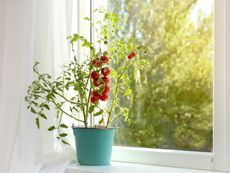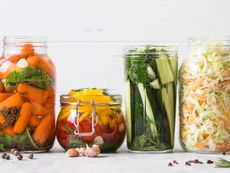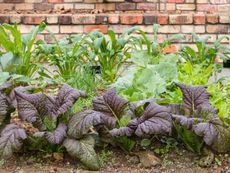Choosing The Size Of Your Vegetable Garden


How big a vegetable garden should be is a common question among people who are considering taking on this task for the first time. While there is no right or wrong way to go about determining the size of your vegetable garden, the general answer is to start small. For starters, it's probably a good idea to figure out what you want to plant, how much you want to plant, and where you want to plant it before you do anything. Garden sizes also depend on the availability of space and how suitable the landscape is for growing plants.
Find the Best Vegetable Garden Size for You
Normally, a garden of about 10 feet by 10 feet (3 x 3 m.) is considered to be manageable, provided your landscape permits the space. You should try sketching out a small diagram noting the area of each vegetable to be planted. If something a little less is preferred, try working vegetables within smaller-sized plots. Since there are many vegetables that are also considered ornamental in appearance, there's no need to hide them from view. In fact, nearly any vegetable can be grown right into your own flower beds as well as in containers. While you want your garden to be large enough to suit your basic needs, you don't want it to be so big that it eventually becomes too demanding. Most people don't have time to deal with all the maintenance and attention a larger vegetable garden requires. As the saying goes, the temptation is the root of all evil; therefore, plant only what you will actually need or use. Resist the urge to plant too many crops; you'll end up paying for it later with backbreaking maintenance such as weeding, irrigating, and harvesting. For example, if you only want tomatoes and cucumbers, then try incorporating these plants into containers. There are numerous varieties to choose from; the bush cucumbers and cherry tomatoes, for example, not only do well in containers but can look quite lovely too. Putting your cucumbers and tomatoes in containers will cut out unnecessary work that would otherwise be involved if you chose to plant these crops in a plot with other vegetables that you may not even use. An alternative approach might include the use of small, raised beds. You could start out with one or two beds of your chosen vegetables. Then, when time and experience permit, you can add another bed or two. For instance, you could choose to have one bed entirely for your tomatoes and the other for your cucumbers. The following year you might want to try your hand at growing squash or beans. By adding more beds, or containers, this expansion is easy. If you plan accordingly, your garden will require less maintenance and will result in more productivity. As it is ultimately your garden, the size will depend on your individual needs as well as those of your landscape. Anything is possible; don't be afraid to experiment. Once you have found a manageable size and layout that works for you, stick with it. In time you will find that you get better and better and so do your vegetables!
Gardening tips, videos, info and more delivered right to your inbox!
Sign up for the Gardening Know How newsletter today and receive a free download of our most popular eBook "How to Grow Delicious Tomatoes."

Nikki Tilley has been gardening for nearly three decades. The former Senior Editor and Archivist of Gardening Know How, Nikki has also authored six gardening books.
-
 Urban Composting Guide: How To Compost In The Middle Of The City
Urban Composting Guide: How To Compost In The Middle Of The CityUrban composting does not have to be daunting. You can compost in the city, and maybe even try some urban worm composting!
By Mary Ellen Ellis
-
 Shrub Diseases And Pests To Watch Out For
Shrub Diseases And Pests To Watch Out ForShrub diseases and pests can be challenging. Learn how to recognize and eradicate them before they can present a danger to your plants.
By Susan Albert
-
 How Many Vegetables To Plant Per Person For A Year
How Many Vegetables To Plant Per Person For A YearGauging how much to plant in a vegetable garden can eliminate waste while still producing enough for your family. Click for more.
By Bonnie L. Grant
-
 13 Perennial Fruits And Vegetables You Only Have To Plant Once
13 Perennial Fruits And Vegetables You Only Have To Plant OnceLooking to set it and forget it? Find out which fruits and vegetables can be grown as perennials.
By Laura Miller
-
 11 Edible Plants For A Year-Round Garden In A Bucket
11 Edible Plants For A Year-Round Garden In A BucketWant to know how to grow food inside your house and which foods do best indoors? Click here to learn all about it.
By Bonnie L. Grant
-
 Frost Tolerance Of Vegetables From Least To Most Hardy
Frost Tolerance Of Vegetables From Least To Most HardyHow cold can vegetables tolerate? Knowing which veggies will survive frosts and freezes is essential for the success of your garden. Click here for more.
By Laura Miller
-
 Best Vegetables To Pickle Straight From The Garden
Best Vegetables To Pickle Straight From The GardenPickles aren’t limited to just cucumbers. Read on for tips on pickling your fresh veggies.
By Amy Grant
-
 Benefits Of Planting In Fall Vs. Spring Vegetable Plots
Benefits Of Planting In Fall Vs. Spring Vegetable PlotsLearn why some vegetables do better if you plant them in fall instead of spring.
By Laura Miller
-
 Interplanting Vegetables In The Fall Garden
Interplanting Vegetables In The Fall GardenLearn all about the benefits of interplanting vegetables for your fall garden.
By Laura Miller
-
 Best Vegetables For Growing In Perlite
Best Vegetables For Growing In PerlitePerlite is a natural growing medium that comes from super-heated volcanic glass. In some cases, it works better than soil. Read on for more info.
By Laura Miller